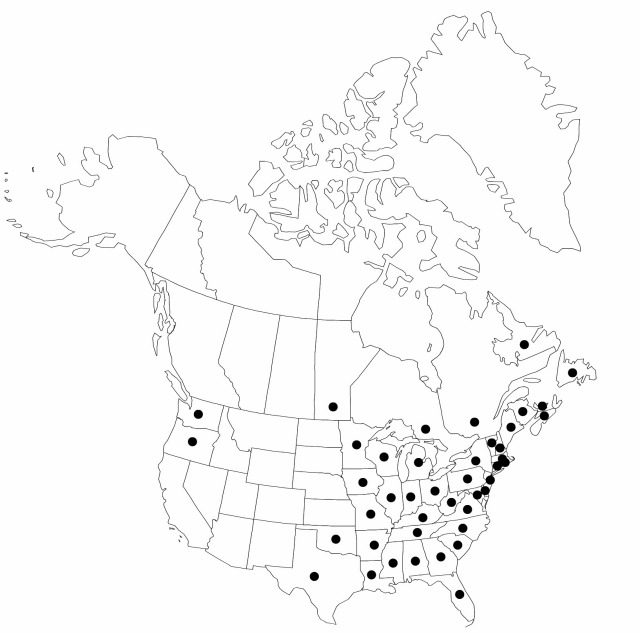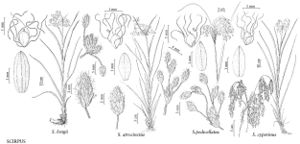Difference between revisions of "Scirpus cyperinus"
Enum. Pl. 2: 170. 1837.
FNA>Volume Importer |
imported>Volume Importer |
||
| (3 intermediate revisions by 2 users not shown) | |||
| Line 8: | Line 8: | ||
}} | }} | ||
|common_names=Scirpe souchet | |common_names=Scirpe souchet | ||
| + | |special_status={{Treatment/ID/Special_status | ||
| + | |code=W1 | ||
| + | |label= | ||
| + | }}{{Treatment/ID/Special_status | ||
| + | |code=F | ||
| + | |label=Illustrated | ||
| + | }} | ||
|basionyms={{Treatment/ID/Basionym | |basionyms={{Treatment/ID/Basionym | ||
|name=Eriophorum cyperinum | |name=Eriophorum cyperinum | ||
|authority=Linnaeus | |authority=Linnaeus | ||
| + | |rank=species | ||
|publication_title=Sp. Pl. ed. | |publication_title=Sp. Pl. ed. | ||
|publication_place=2, 1: 77. 1762 | |publication_place=2, 1: 77. 1762 | ||
| Line 17: | Line 25: | ||
|name=Scirpus cyperinus var. andrewsii | |name=Scirpus cyperinus var. andrewsii | ||
|authority=(Fernald) Fernald | |authority=(Fernald) Fernald | ||
| + | |rank=variety | ||
}} {{Treatment/ID/Synonym | }} {{Treatment/ID/Synonym | ||
|name=Scirpus cyperinus var. pelius | |name=Scirpus cyperinus var. pelius | ||
|authority=Fernald | |authority=Fernald | ||
| + | |rank=variety | ||
}} {{Treatment/ID/Synonym | }} {{Treatment/ID/Synonym | ||
|name=Scirpus rubricosus | |name=Scirpus rubricosus | ||
| − | |authority= | + | |authority= |
| + | |rank=species | ||
}} | }} | ||
|hierarchy=Cyperaceae;Scirpus;Scirpus cyperinus | |hierarchy=Cyperaceae;Scirpus;Scirpus cyperinus | ||
| Line 39: | Line 50: | ||
|distribution=Man.;N.B.;Nfld. and Labr.;N.S.;Ont.;P.E.I.;Que.;Ala.;Ark.;Calif.;Conn.;Del.;Fla.;Ga.;Ill.;Ind.;Iowa;Ky.;La.;Maine;Md.;Mass.;Mich.;Minn.;Miss.;Mo.;Mont.;N.H.;N.J.;N.Y.;N.C.;Ohio;Okla.;Oreg.;Pa.;R.I.;S.C.;Tenn.;Tex.;Vt.;Va.;Wash.;W.Va.;Wis.;Wyo.;Mexico. | |distribution=Man.;N.B.;Nfld. and Labr.;N.S.;Ont.;P.E.I.;Que.;Ala.;Ark.;Calif.;Conn.;Del.;Fla.;Ga.;Ill.;Ind.;Iowa;Ky.;La.;Maine;Md.;Mass.;Mich.;Minn.;Miss.;Mo.;Mont.;N.H.;N.J.;N.Y.;N.C.;Ohio;Okla.;Oreg.;Pa.;R.I.;S.C.;Tenn.;Tex.;Vt.;Va.;Wash.;W.Va.;Wis.;Wyo.;Mexico. | ||
|discussion=<p><i>Scirpus cyperinus</i> is extremely variable. A form common in the northern part of its range, south to Iowa, northern Ohio, Maryland, and (in the Appalachians) North Carolina and Tennessee, has bases of the involucral bracts and the involucels blackish, the spikelets sessile or nearly so in glomerules, and the scales relatively short, ovate, and brownish. This form has often been treated as <i>S. cyperinus</i> var. pelius. A more robust southern form, extending north to southern Missouri and Illinois, Kentucky, Virginia, and (along the coast) New Jersey and Massachusetts, has the bases of the involucral bracts and the involucels reddish brown, the spikelets mostly solitary, and the scales relatively long, narrowly elliptic, and reddish brown. This form has often been treated as a distinct species, S. rubricosus (or under the illegitimate name S. eriophorum Michaux). These two morphologies intergrade so extensively that it is not practical to recognize them taxonomically at any rank.</p><!-- | |discussion=<p><i>Scirpus cyperinus</i> is extremely variable. A form common in the northern part of its range, south to Iowa, northern Ohio, Maryland, and (in the Appalachians) North Carolina and Tennessee, has bases of the involucral bracts and the involucels blackish, the spikelets sessile or nearly so in glomerules, and the scales relatively short, ovate, and brownish. This form has often been treated as <i>S. cyperinus</i> var. pelius. A more robust southern form, extending north to southern Missouri and Illinois, Kentucky, Virginia, and (along the coast) New Jersey and Massachusetts, has the bases of the involucral bracts and the involucels reddish brown, the spikelets mostly solitary, and the scales relatively long, narrowly elliptic, and reddish brown. This form has often been treated as a distinct species, S. rubricosus (or under the illegitimate name S. eriophorum Michaux). These two morphologies intergrade so extensively that it is not practical to recognize them taxonomically at any rank.</p><!-- | ||
| − | --><p><i>Scirpus cyperinus</i> often hybridizes with <i>S. atrocinctus</i> and <i>S. pedicellatus</i>, forming hybrid swarms. Some plants appear to have characteristics of all three species; the names <i>Scirpus atrocinctus</i> < | + | --><p><i>Scirpus cyperinus</i> often hybridizes with <i>S. atrocinctus</i> and <i>S. pedicellatus</i>, forming hybrid swarms. Some plants appear to have characteristics of all three species; the names <i>Scirpus atrocinctus</i> <i></i>var.<i> grandis</i> Fernald and <i>S. atrocinctus</i> forma grandis (Fernald) D. S. Carpenter are based on such a specimen.</p> |
|tables= | |tables= | ||
|references= | |references= | ||
| Line 48: | Line 59: | ||
-->{{#Taxon: | -->{{#Taxon: | ||
name=Scirpus cyperinus | name=Scirpus cyperinus | ||
| − | |||
|authority=(Linnaeus) Kunth | |authority=(Linnaeus) Kunth | ||
|rank=species | |rank=species | ||
| Line 62: | Line 72: | ||
|publication title=Enum. Pl. | |publication title=Enum. Pl. | ||
|publication year=1837 | |publication year=1837 | ||
| − | |special status= | + | |special status=W1;Illustrated |
| − | |source xml=https:// | + | |source xml=https://bitbucket.org/aafc-mbb/fna-data-curation/src/2e0870ddd59836b60bcf96646a41e87ea5a5943a/coarse_grained_fna_xml/V23/V23_20.xml |
|genus=Scirpus | |genus=Scirpus | ||
|species=Scirpus cyperinus | |species=Scirpus cyperinus | ||
Latest revision as of 20:39, 5 November 2020
Plants aggregated in dense tussocks; rhizomes branching, short, tough, fibrous. Culms: fertile ones upright or nearly so; nodes without axillary bulblets. Leaves 5–10 per culm; sheaths of proximal leaves green to red-brown; proximal sheaths and blades with septa few to many, conspiucuous or inconspicuous; blades 22–80 cm × 3–10 mm. Inflorescences terminal; rays ascending or sometimes spreading, scabrous throughout or main branches smooth proximally, rays without axillary bulblets; bases of involucral bracts reddish brown, brownish, or blackish, not glutinous. Spikelets in dense cymes of 2–15, central spikelet of each cyme sessile, others sessile or pedicellate, spikelets broadly ovoid, ovoid, or sometimes cylindric, 3.5–8 × 2.5–3.5 mm; scales reddish brown, brownish, or blackish, ovate or narrowly ovate to oblong-ovate or oblong-elliptic, 1.1–2.2 mm, apex apiculate or short-mucronate, apiculus or mucro to 0.1 mm. Flowers: perianth bristles persistent, 6, slender, contorted, much longer than achene, smooth, projecting beyond scales, mature inflorescence appearing woolly; styles 3-fid. Achenes whitish to very pale brown, elliptic or obovate in outline, plumply trigonous or plano-convex, 0.6–0.9 × 0.3–0.5 mm. 2n = 66.
Phenology: Fruiting late summer–early fall (Aug–Sep, earlier in s United States).
Habitat: Marshes, moist meadows, ditches, shallow ponds, frequently growing in disturbed areas
Elevation: 0–800 m
Distribution

Man., N.B., Nfld. and Labr., N.S., Ont., P.E.I., Que., Ala., Ark., Calif., Conn., Del., Fla., Ga., Ill., Ind., Iowa, Ky., La., Maine, Md., Mass., Mich., Minn., Miss., Mo., Mont., N.H., N.J., N.Y., N.C., Ohio, Okla., Oreg., Pa., R.I., S.C., Tenn., Tex., Vt., Va., Wash., W.Va., Wis., Wyo., Mexico.
Discussion
Scirpus cyperinus is extremely variable. A form common in the northern part of its range, south to Iowa, northern Ohio, Maryland, and (in the Appalachians) North Carolina and Tennessee, has bases of the involucral bracts and the involucels blackish, the spikelets sessile or nearly so in glomerules, and the scales relatively short, ovate, and brownish. This form has often been treated as S. cyperinus var. pelius. A more robust southern form, extending north to southern Missouri and Illinois, Kentucky, Virginia, and (along the coast) New Jersey and Massachusetts, has the bases of the involucral bracts and the involucels reddish brown, the spikelets mostly solitary, and the scales relatively long, narrowly elliptic, and reddish brown. This form has often been treated as a distinct species, S. rubricosus (or under the illegitimate name S. eriophorum Michaux). These two morphologies intergrade so extensively that it is not practical to recognize them taxonomically at any rank.
Scirpus cyperinus often hybridizes with S. atrocinctus and S. pedicellatus, forming hybrid swarms. Some plants appear to have characteristics of all three species; the names Scirpus atrocinctus var. grandis Fernald and S. atrocinctus forma grandis (Fernald) D. S. Carpenter are based on such a specimen.
Selected References
None.
